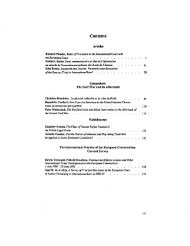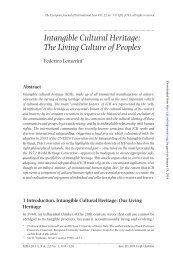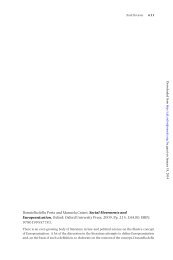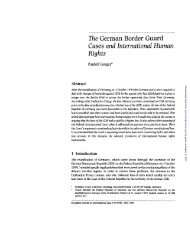Genocide and Restitution - European Journal of International Law
Genocide and Restitution - European Journal of International Law
Genocide and Restitution - European Journal of International Law
You also want an ePaper? Increase the reach of your titles
YUMPU automatically turns print PDFs into web optimized ePapers that Google loves.
<strong>Genocide</strong> <strong>and</strong> <strong>Restitution</strong>: Ensuring Each Group’s Contribution to Humanity 33<br />
The 1954 Hague Convention preamble replicates the justification for the criminalization<br />
<strong>of</strong> genocide articulated by the UNWCC <strong>and</strong> Lemkin as the rationale for the<br />
international protection <strong>of</strong> cultural property during armed conflict <strong>and</strong> belligerent<br />
occupation. The preamble explicitly acknowledges the importance <strong>of</strong> the contribution<br />
<strong>of</strong> each group to ‘the cultural heritage <strong>of</strong> mankind’, <strong>and</strong> its purposes <strong>and</strong> enumerated<br />
obligations implicitly conceded the importance <strong>of</strong> cultural property to the<br />
groups themselves in ensuring their ‘contribution’. 103 There is deliberate reference to<br />
the cultural heritage <strong>of</strong> ‘peoples’ rather than states. 104 This phrase recognizes that the<br />
bond certain cultural property has with the culture <strong>and</strong> history <strong>of</strong> a people transcends<br />
national borders. 105 This aspect <strong>of</strong> the convention is reinforced through its application<br />
during international <strong>and</strong> non-international armed conflicts. 106<br />
2 The 1954 Hague Protocol<br />
In their studies prepared for proposed specialist instruments for the protection <strong>of</strong> cultural<br />
property during armed conflict <strong>and</strong> belligerent occupation after World Wars I<br />
<strong>and</strong> II, Charles de Visscher <strong>and</strong> Berlia respectively addressed the issue <strong>of</strong> restitution<br />
<strong>of</strong> cultural property. De Visscher provided a lengthy, detailed history <strong>of</strong> practice in<br />
support <strong>of</strong> the draft Declaration Concerning the Protection <strong>of</strong> Historic Buildings <strong>and</strong><br />
Works <strong>of</strong> Art in Time <strong>of</strong> War <strong>and</strong> draft <strong>International</strong> Convention covering restitution<br />
during war <strong>and</strong> in peacetime, 107 whilst Berlia’s work in the lead-up to the eventual<br />
adoption <strong>of</strong> the 1954 Hague Convention <strong>and</strong> Protocol focused not only on the 1919<br />
Commission’s efforts but the extensive Allied restitution programmes. 108<br />
The Protocol for the Protection <strong>of</strong> Cultural Property in the Event <strong>of</strong> Armed Conflict<br />
(Hague Protocol) modified <strong>and</strong> codified the developments achieved in respect <strong>of</strong> the<br />
restitution <strong>of</strong> cultural property following World War II. 109 This was the first time restitutory<br />
relief specifically in respect <strong>of</strong> violations <strong>of</strong> the laws <strong>and</strong> customs <strong>of</strong> war relating<br />
to cultural property had been codified in international law, <strong>and</strong> was made prospective<br />
<strong>and</strong> potentially universal in application. With reaffirmation that cultural property<br />
cannot be retained as war reparations <strong>and</strong> that there is no time limit for lodging claims<br />
103<br />
Second recital, Preamble, 1954 Hague Convention, supra note 1. See Art. 53 <strong>of</strong> the Protocol Additional<br />
to the Geneva Conventions <strong>of</strong> 1949, <strong>and</strong> Relating to the Protection <strong>of</strong> Victims <strong>of</strong> <strong>International</strong> Armed<br />
Conflicts, 8 June 1977, in force 7 Dec. 1978, 1125 UNTS 3, <strong>and</strong> Art. 16 <strong>of</strong> the Protocol Additional to the<br />
Geneva Conventions <strong>of</strong> 1949, <strong>and</strong> Relating to the Protection <strong>of</strong> Victims <strong>of</strong> Non-<strong>International</strong> Armed Conflicts,<br />
8 June 1977, in force 7 Dec. 1978, 1125 UNTS 609 which also refer to religious significance. The<br />
1954 Hague Convention also covers sites, monuments, <strong>and</strong> objects <strong>of</strong> religious importance: Art. 1(1).<br />
104<br />
UNESCO Doc. 7C/PRG/7, Annex II, at 20. Amendment proposed by USSR: Doc. CBC/DR/37.<br />
105<br />
Official Records <strong>of</strong> the Diplomatic Conference on the Reaffirmation <strong>and</strong> Development <strong>of</strong> <strong>International</strong><br />
Humanitarian <strong>Law</strong> applicable in Armed Conflicts (1974–1977), xv, at 220.<br />
106<br />
Art. 19, <strong>of</strong> the1954 Hague Convention, supra note 1.<br />
107<br />
De Visscher, ‘<strong>International</strong> Protection <strong>of</strong> Works <strong>of</strong> Art <strong>and</strong> Historic Monuments’, in Department <strong>of</strong> State<br />
Publication 3590, <strong>International</strong> Information <strong>and</strong> Cultural Series 8, reprinted in Documents <strong>and</strong> State Papers,<br />
June 1949, at 821.<br />
108<br />
Berlia, supra note 101, at 9–11.<br />
109<br />
14 May 1954, in force 7 Aug. 1956, 249 UNTS 358. See UNESCO Docs CL/717, Annex IV, at 46–47,<br />
<strong>and</strong> 7C/PRG/7, Annex.<br />
Downloaded from http://ejil.oxfordjournals.org/ by guest on January 18, 2014








